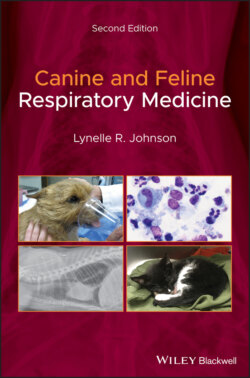Читать книгу Canine and Feline Respiratory Medicine - Lynelle Johnson R., Lynelle R. Johnson - Страница 42
Airway Sampling Transoral Tracheal Wash
ОглавлениеA transoral tracheal wash is appropriate for use in large and small dogs or in cats. A sterile endotracheal tube and a sterile polypropylene or open‐ended red rubber catheter (3.5–8 French) are needed. Prior to doing a tracheal wash, the catheter should be measured against the animal and marked at a position that estimates the location of the carina, which is approximately at the fourth intercostal space (Figure 2.3). Passing the catheter too far distally can result in airway damage. The animal is anesthetized with a short‐acting anesthetic agent. Options include propofol or alfaxalone with midazolam, or ketamine with valium (a 1 : 1 mixture). Lubricant should not be used on the endotracheal tube because it can adversely affect cytology results. Prior to intubation, the function of the larynx is assessed to ensure normal abduction on inspiration. In the cat, local lidocaine can be used to facilitate intubation and avoid contamination of the tube through contact with oropharyngeal or laryngeal mucosa, although being patient while drugs take effect generally allows a clean intubation. An assistant holds the endotracheal tube in place during the lavage.
Figure 2.3 (a and b) The urinary catheter used to collect an airway sample during a tracheal wash is measured to approximately the fourth rib (*) to avoid passing the catheter beyond the level of the carina (C).
With the endotracheal tube held in place, the polypropylene or red rubber catheter is passed sterilely through the tube to the fourth intercostal space, and the three‐way stopcock with syringe is attached to the outer port. An aliquot of saline (4–6 ml) is instilled into the airway followed by 2–3 ml of air to ensure that all fluid has exited the catheter (Figure 2.4). The stopcock is turned off to the syringe and either hand suction or house suction can be applied to aspirate fluid and cells from the lower airway. Use of a sterile suction trap (Figure 2.5) can be beneficial in collecting the sample when house suction is used. If retrieval of fluid is less than desired, the cuff of the endotracheal tube can be inflated to improve suction. Retrieval of fluid can also be enhanced by having the assistant compress the chest, perform coupage, or stimulate a cough during suction. Instillation and aspiration of fluid can be repeated several times until an adequate sample has been retrieved. Typically ~1.0 ml is sufficient for culture and cytology.
Figure 2.4 A three‐way stopcock is turned on to the urinary catheter used to collect the airway wash and off to the suction catheter.
A modification of the transoral tracheal wash can be performed, which yields a sample more closely approximating that of a bronchoalveolar lavage (BAL). In the dog, this is achieved using a 16‐French Argyle™ stomach tube (Sherwood Medical Co./Tyco Healthcare Kendall, Deland, FL; Hawkins and Berry 1999). The dog must be large enough to accommodate an endotracheal tube that will not be fully occluded by the stomach tube. The stomach tube is shortened to remove any side holes on the distal end and to create a length that approximates the distance from the endotracheal tube to the last rib. The distal end of the tube can be tapered with a sterile pencil sharpener to improve the ability to wedge within the airway, and the tube should be sterilized prior to use. Endotracheal intubation is carried out using a short‐acting anesthetic agent (e.g. propofol or alfaxalone with midazolam) and a sterile endotracheal tube. The dog is placed in dorsal recumbency, and the modified stomach tube is passed slowly through the lumen of the endotracheal tube until it meets resistance. Gentle pressure should be used when passing and wedging this tube to avoid perforating the lung. As soon as slight resistance is encountered, the tube is withdrawn 1–2 cm and lavage is initiated with 20 ml of sterile saline followed by 5 ml of air. An adaptor might be needed to fit the syringe to the stomach tube. Gentle hand suction is applied to retrieve the fluid, and a second aliquot can be instilled as needed.
Figure 2.5 A suction trap can be secured below the patient during the tracheal wash. One tube is connected to the three‐way stopcock and catheter used for the tracheal wash, while the other is connected to a suction device.
Non‐bronchoscopic BAL has also been reported in the cat, and the cell distribution obtained on cytology matches that found with bronchoscopy (Hawkins et al. 1994). For this procedure, the cat is anesthetized and intubated with a sterile endotracheal tube similar to the method used for a transoral tracheal wash. The cuff is inflated and the cat is placed in lateral recumbency with the most affected side down. Aliquots of warmed sterile 0.9% saline (5 ml/kg, 1–3 aliquots) are instilled directly into the endotracheal tube using a 35 ml syringe with syringe adapter. Fluid is retrieved by hand aspiration. Elevating the hindquarters can facilitate collection, and approximately 65–70% fluid retrieval should be expected. Alternately, a urinary catheter (6–8 French) can be passed gently through a sterile endotracheal tube until resistance is met (Foster et al. 2004), in a manner similar to that employed when a modified stomach tube is used to perform blind BAL in a dog. Instillation and aspiration of 5–10 ml of sterile saline provide an adequate lavage sample for cultures and cytology. With either procedure, respiratory rate and pulse oximetry should be monitored to detect untoward reactions and oxygen supplied as needed. In cats, pre‐treatment with terbutaline (0.01 mg/kg subcutaneously) is recommended prior to any airway procedure.
